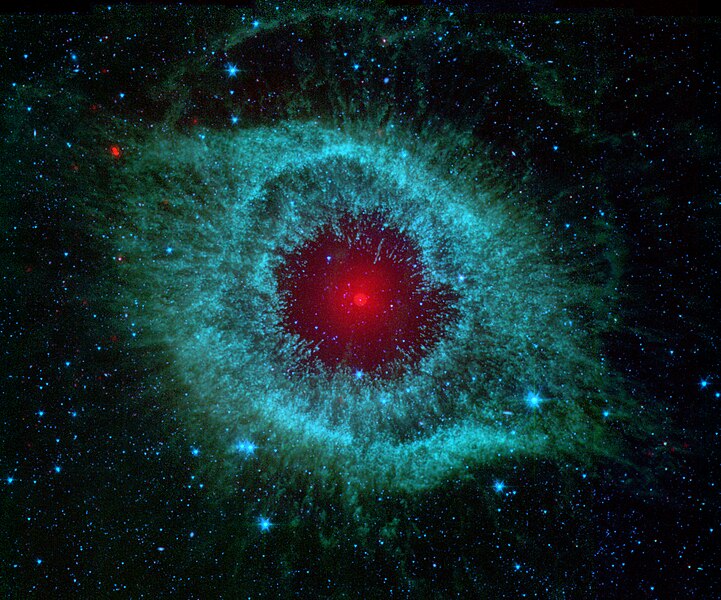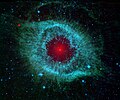Податотека:Comets Kick up Dust in Helix Nebula (PIA09178).jpg

Големина на овој преглед: 721 × 600 пиксели. Други разделности: 289 × 240 пиксели | 577 × 480 пиксели | 923 × 768 пиксели | 1.231 × 1.024 пиксели | 2.462 × 2.048 пиксели | 4.279 × 3.559 пиксели.
Изворна податотека (4.279 × 3.559 пиксели, големина: 7,22 МБ, MIME-тип: image/jpeg)
Историја на податотеката
Стиснете на датум/време за да ја видите податотеката како изгледала тогаш.
| Датум/време | Минијатура | Димензии | Корисник | Коментар | |
|---|---|---|---|---|---|
| тековна | 04:43, 13 февруари 2007 |  | 4.279 × 3.559 (7,22 МБ) | Startaq | {{Information |Description=This infrared image from NASA's Spitzer Space Telescope shows the Helix nebula, a cosmic starlet often photographed by amateur astronomers for its vivid colors and eerie resemblance to a giant eye. The nebula, located about 700 |
Употреба на податотеката
Податотекава се користи во следниве 2 страници:
Глобална употреба на податотеката
Оваа податотека ја користат и следниве викија:
- Употреба на af.wiki.x.io
- Употреба на ar.wiki.x.io
- Употреба на arz.wiki.x.io
- Употреба на ast.wiki.x.io
- Употреба на ba.wiki.x.io
- Употреба на bg.wiki.x.io
- Употреба на bjn.wiki.x.io
- Употреба на bn.wiki.x.io
- Употреба на br.wiki.x.io
- Употреба на ca.wiki.x.io
- Употреба на cs.wiki.x.io
- Употреба на de.wiki.x.io
- Употреба на dsb.wiki.x.io
- Употреба на en.wiki.x.io
- Helix Nebula
- Spitzer Space Telescope
- Comet nucleus
- Talk:Helix Nebula
- User:Swirlex/Userboxes
- User:Swirlex/Userboxcode
- NASA
- Wikipedia:Featured pictures/Space/Looking out
- User:Nonexyst
- User:Benjamin112
- Portal:Outer space/Selected picture
- User:Sunfishtommy/sandbox
- Wikipedia:Featured pictures thumbs/44
- Wikipedia:Featured picture candidates/October-2014
- User talk:Benison/Archive 19
- Wikipedia:Featured picture candidates/The God's Eye
- Wikipedia:Picture of the day/October 2016
- Template:POTD/2016-10-12
- Wikipedia:Main Page history/2016 October 12
- User talk:69.50.70.9
- User:The NMI User
- User:Corinne/subpage
- User talk:Benison/Archive 37
- Wikipedia:Userboxes/Science/Astronomy
- User:Catfurball
- User:Huggums537
Погледајте ја останатата глобална употреба на податотекава.



